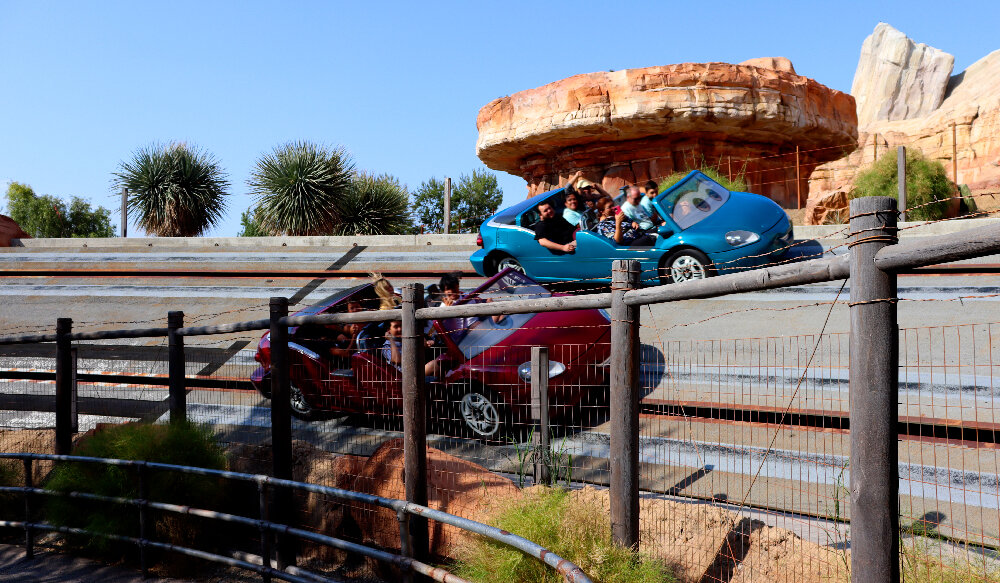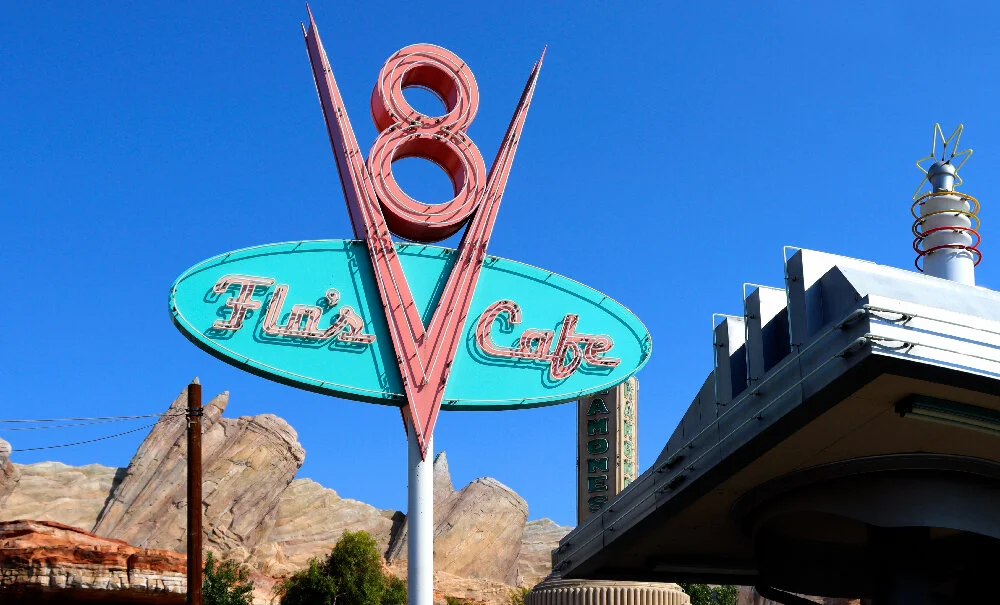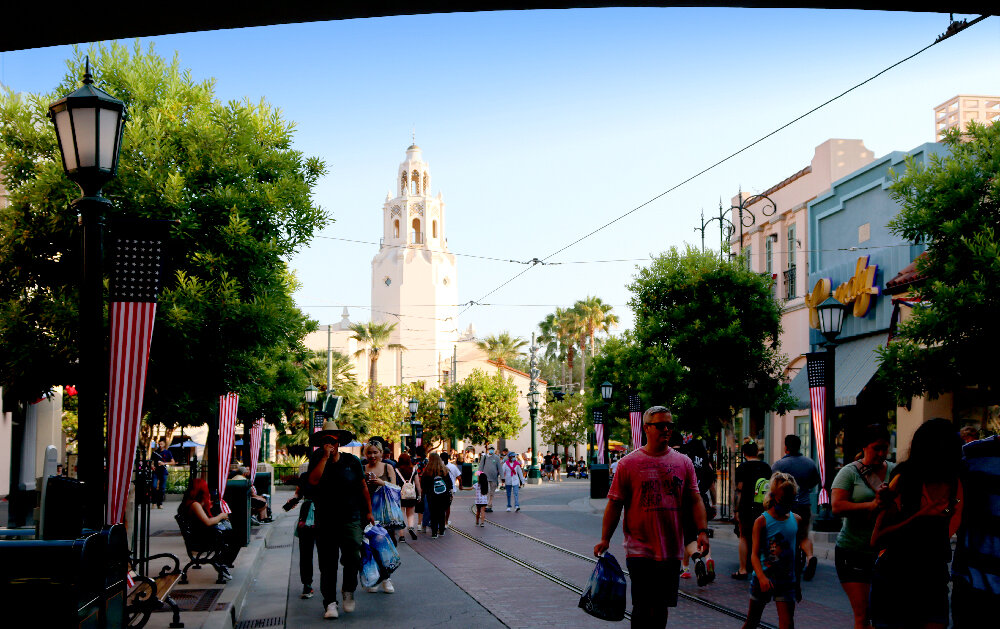DCA Then and Now - Part 6: Radiating Springs.
Cars Land is a home run example of thematic design by day. I think my prior two posts establish that. Now, it’s true that theme parks in general—and the Disney parks in particular—tend to look great after dark. But I think this built environment manifestation of Radiator Springs takes it to a higher level, because it’s actually an expression of some key moments from the film Cars itself.
Radiator Springs bereft of neon at the start of Cars.
The first time we see Radiator Springs during that first night early on in the film, it looks pretty sad. Most of the lights are dead, and those that remain are flickering eerily. We as the audience get the message immediately; the town has been passed by.
Neon re-lighting sequence in Cars.
On Lightning McQueen’s last night in town—just before the media track him down and he gets carted off to the big race—there’s a charming scene set to "Sh-Boom (Life Could Be a Dream)” by The Chords. All of the neon signage in Radiator Springs has been restored and comes to life. The animation is really well done, and the choreography of the vehicles as they “dance” down the street is especially engaging. Basically, if you talk to anyone who has seen Cars at least once, they’ll probably recall it.
It’s the magic of this celebratory part of the movie that is recreated in Cars Land every night at twilight. The lights don’t come on all at once. They do come on quickly, but there’s a subtle sequence, like someone turning on strings of Christmas lights one by one.
At Disneyland next door there’s a special vibe during twilight, sure. But it’s all incandescent and twinkle lights. The neon on display here has a completely different feeling.
There’s also a different type of nostalgia being expressed. Over on Main Street USA it’s about the quaint charm of early electric lighting (the street is lined with both gas lamps and electric bulbs). That setting (early 1900s) is when electricity was cutting edge technology.
Neon first became popular in the United States during the 1920s and 30s , but in terms of Americana its peak power was during the 1950s and early 60s. Thus—apart from Las Vegas and Reno—many Americans associate neon with the middle of the twentieth century.
Its use in Cars was certainly a deliberate play on nostalgic Baby Boomers’ heartstrings as they watched the film with their children and grandchildren.
But neon is not the only effect used. Like at Disney’s other parks, both spot lighting and atmospheric arrangements are used to heighten the emotional resonance of themed spaces.
Careful attention was paid to make sure that the proprietorships look in person the way they do in the film. Some, like Mater’s tow yard, are never seen in Cars at night, but are imagined in a way that matches those that are.
As LED technology has improved in both luminosity and cost (particularly of high-brightness units), Disney has steadily adopted it throughout their environments. Like in our homes, the energy is cleaner and cheaper. The designers are particularly adept at using fixtures and trimmings that fake us into thinking these are all incandescent bulbs of a far older vintage.
More theatrical stage lighting is still employed liberally for certain effects.
Psychedelic projections at Fillmore’s in Cars.
In this case the designers are trying to approximate what is actually animated in the film.
Motion is replicated too. Commonly, neon signs of the mid-century period had elements which created the illusion of motion or animation as a way to catch eyes from a moving car.
Sarge’s moving neon in Cars.
In the case of the sign on Sarge’s Surplus Hut, it’s a projectile being launched.
On the sign for the Cozy Cone Motel, the “Z’s” rise from a car sleeping soundly.
Cozy Cone in Cars.
Just like in the film. Incidentally, it’s this motel sign that says “Mid-Century Americana” to me the most, of all the signs in Cars Land.
I can’t recall if the tail light flowers are seen at night in the film, but they look great in Cars Land. Just the right amount of glow, which appears to have been achieved with LEDs.
Just like all the structures themselves, the Disney Imagineers had the 3D models and digital wireframes from the film from which to base their signage construction drawings on. The movie is the literal blueprint.
FLo’s in Cars at night.
The thing that really impressed me though, was the color of the neon. It’s not just “close enough” it’s a perfect match.
As a designer I’ve had my share of color matching nightmares over the years. From screen to print and back again. Different devices, wildly varying gamuts, incorrect profiles.
The Flo’s Cafe sign lights up in Cars.
The sequential nature of the town’s signage coming alive is highlighted at Flo’s in particular. The camera swoops up as each part comes on, one at a time.
the V8 crown at the top of the sign.
Look carefully at the colors.
It’s spot-on in Cars Land, to the point of being uncanny.
The lighting at the curios shop fits with its roadside kitsch vibe. Twinkle lights with lots of irregular fixtures and sconces. The impression is that all of this accumulated over time.
Radiator Springs Curios alight in Cars.
It was only after watching Cars carefully as I was preparing this post that was like (dang!) they nailed it completely. There are some different proportions and changes to the façade, but as for the lighting effects, it’s 1:1 for what we see in the film.
Kitty-corner across the intersection is another temple of neon at Ramone’s House of Body Art. The scheme is bright green and purple, which reminds me of a sports team or the branding for an energy drink (thus it’s a combination many designers avoid).
Ramone’s at night in Cars.
In the film it’s a bit more blue to my eyes.
The height is impressive in person.
All the smaller script bits in the windows are the same as in the film.
The bluer Ramone’s of Cars.
Yet note the darker, blue-ish interior of the “Body Art” lettering in particular. My guess, based on how they nailed everything else so closely, is that the designers couldn’t replicate the color effect in quite the same way with the physical neon installation as built.
Luigi’s is pretty much the same as in the film.
Luigi’s lit up in Cars.
Even the tower of tires is lit with internal spots (likely LEDs) and the string lights hung above are the same.
I particularly like this smaller logo on the side of the building facing Route 66.
I’ve mentioned in the prior posts how Cars Land expands upon the Radiator Springs we see in the film, extrapolating spaces and so forth. But there’s another kind of expansion going on—temporal. We can spend all the time we want in this version of the town (at least while DCA is open), examining various details in depth.
In Cars, most of these smaller signs are seen lit up very briefly.
The Sparky’s sign is visible for only seconds of screen time.
Smaller neon signs in Cars.
Also, we are only shown the neon signs from particular vantages. Walking around Cars Land at night, you can pick any angle to look at them. The themed space thus expands both time and perspective of its transmediated source.
Disney always has jokes intended for children and more subtle nods that only the grownups are going to catch. Like this bar-as-tune up joint “We’re Open” sign with a small nut for the olive in the martini glass.
It’s not my intention to belabor this point. But there is a confluence of forces at work that make Cars Land at night among the best-realized and affective themed spaces I’ve ever seen. In that it expresses, aesthetically—a truth about its source material.
It’s not just about the design. For one, the neon caries emotional and symbolic weight in the story of the film. We don’t just see the neon in Cars and then see the same thing in Cars Land like any other scenic aspect of the movie.
The conclusion of the neon processional in Cars.
The neon represents the prosperity of Radiator Springs. As in the lights are on and—as the above martini boasts—“We’re Open for Business!” The musical number is nothing short of a processional, a pageant, a parade in which Lightning McQueen demonstrates his true affection for the town and its citizens whom he has befriended. Right before he is whisked away to the big race.
And because the neon coming alive is repeated every single operating day at the same time, twilight, this procession as seen in the film becomes ritualized. It’s like the first lighting of the town Christmas Tree, every single night. Which at DCA is typically 365 days a year.
A few last notes about the nighttime ambiance of Radiator Springs Racers and its queue.
The designers first started doing this kind of stuff in the Frontierland area of Disneyland, and Big Thunder Mountain especially stands out. In the early years the Matterhorn was not lit at night in any special way (this wasn’t added until the attraction was redone in the late 1970s).
In the decades since, the Disney Imagineers have become experts in the art of backlighting with spots; this technique of course comes from filmmaking.
Themed lighting fixtures appropriate to the setting—which tend to be realistic—are augmented with a very otherworldly treatment on all the surrounding rockwork. If you’ve been to any kind of themed space with rockwork on display at night—from Las Vegas to Dubai—you’ve seen this. DIsney invented it.
I have no idea what you’d call this, because I’ve been looking at it since I was a child. Mountains and canyons inside a Disney park are just supposed to look like this at night. In fact, as I got a bit older and spent more time in the great outdoors, camping and going to national parks and the like, my first reaction was that I was stunned how dark everything actually is once the sun goes down. Which is one of the primary appeals of such places. Without light pollution, the landscape of the earth recedes and the stars dominate the night sky. Any trace of civilization evaporates.
Within the theme park, however, the stars of the show are the designers with their neon and LEDs and elaborately glowing rockscapes.













